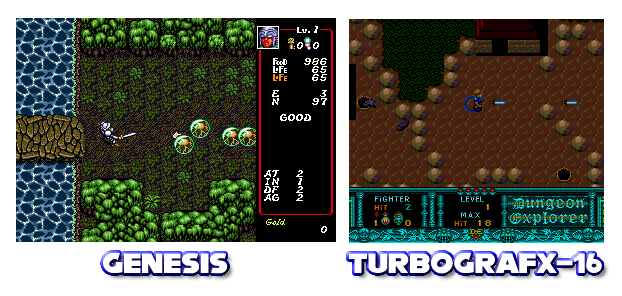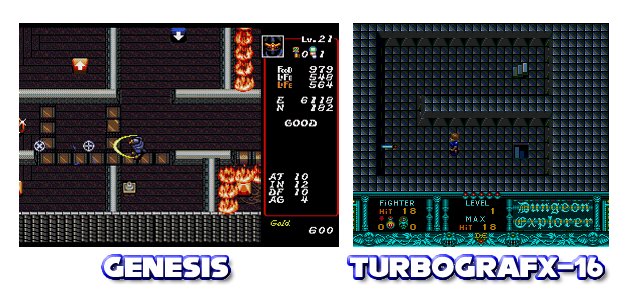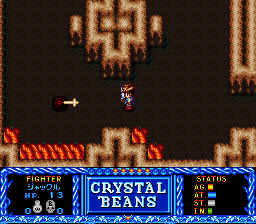When it first appeared on the Turbo Grafx-16 back in 1989, Dungeon Explorer it enticed gamers with its excellent five-player gameplay. A hack-‘n-slasher in the same vein as Gauntlet, it was a unique experience on the console, and even though Turbo owners had to buy a Turbo Tap to be able to use multi-player modes, the extra expense was worth it. Being able to tackle each dungeon with your friends in tow was an awesome experience, and gave the relatively straight-forward gameplay a brilliance that kept you coming back. It was a party game before there were even party games, and it built upon the foundation, set by Gauntlet, of requiring team work to reach the intended goal. More importantly, one must bear in mind that this was years before making games compatible with more than two players was considered the norm. Since you needed the Turbo Tap to play with even a single person, just about anyone with the console already had one, making the game easily accessible and a definite purchase.
Almost five years later, Hudson Soft released Dungeon Explorer on the Sega CD. Though the basic premise was the same (a hack-‘n-slash adventure where you passed dungeons in order to reach a final boss), almost everything else was changed or upgraded. Hudson Soft redid the game from the ground up, even changing the menu to a bar on the right-hand part of the screen. The new version took advantage of all the bells and whistles of Sega’s new technology, and seems more like a refined vision of what the game should have been than something entirely different. Mind you, I’m not saying the CD version is superior, as it’s different enough from the HuCard original to warrant having both. After spending some time with the two of them, however, it becomes evident that the limits of the TurboGrafx hardware kept the game from reaching its full potential.
The Differences
Plot: Why Hudson Soft decided to change the storyline in a game that requires almost none to begin with is beyond me. Hack-‘n-slashers are all about cutting foes up, and no one really cares why it’s done. Did you really care why Death Adder had the Golden Axe or why Rastan was even fighting? I didn’t think so.
The Turbo game describes the land of Oddesia being ruled by a cruel alien race, who are anxiously searching for the sacred ORA Stone. Supposedly, the stone is the last glimmer of hope the residents of Oddesia have against their captors, and you are the only one able to find it before the aliens do.
On CD, things take a different turn. Long ago, the evil Darkling imprisoned the Goddess of Ambition in his tower, forever keeping her powers in check. She has promised to grant one wish to whomever is able to defeat his forces and rescue her. No one has ever returned from Darkling Tower, and it is unknown whether or not the Goddess even exists.
I have to admit, I’m more partial to the Sega CD story. The thought of alien invaders conquering an ancient land just doesn’t gel with me, and while the other is more cliché, it makes more sense, given the type of game we’re dealing with here.

Edge: Sega CD
Graphics: The first difference you’re likely to notice, and it’s where the Sega CD’s better hardware is most apparent. There is a better use of color on the TurboGrafx, given its ability to display half of its palette onscreen (256 colors). This gives it a nice, natural feel. Everything looks very clear, and you’d really be doing the game an injustice by playing through RF (does anyone still?). Text is easily readable and the playfield is wide and a breeze to navigate. You won’t confuse enemies with rocks or that sort of thing, and everything holds up pretty well, given how much time has past since Dungeon Explorer first came out.
The CD game has more detailed graphics, and little details, like reflections in the ice and trees moving, are very well done. Characters and monsters are also more detailed and better presented. The Sega CD might not be as colorful as the TurboGrafx, but its powerful processor was capable of doing wonders with what was available. Developers had a pretty good handle on how to stretch things by 1993, and Dungeon Explorer benefits from the expanded use of shading and extra detail. Where the Sega CD blows the Turbo out of the water here is via its support of s-video. If you’re lucky enough to have a Genesis modded for such output, there is simply no comparison. The quality of the visuals is so much better than through the Turbo’s RF or composite cable that it’s an easy choice.

Edge: Sega CD
Sound/Music: The TG gives some nice, crisp stereo sound, and the tunes sound very nice. I love the Turbo’s particular style of sound (it’s instantly recognizable) and there’s no denying the charm of the simple, yet well-composed score. If you are playing through a Turbo Booster or Duo, then you can really appreciate the clear quality of the soundtrack.
For all its charm though, it can’t compete with a great CD soundtrack. The CD music just sounds so much better, and the inclusion of Gauntlet-style voices (“yum,” “help”) just make the game cooler on CD. Even more impressive than the range of tunes you’ll find, is that they’re red book. This means you can pop the CD in your stereo and hear the soundtrack at will!
Natas’ Lair: (TurboGrafx-16 MIDI) Track #3: (Sega CD Red book Audio)
Edge: Draw
Characters: Here the TG stands out. With 8 classes (fighter, thief, warlock, witch, bard, bishop, elf, gnome), it offers more variety than the Sega CD’s six classes (knight, monk, elf, mage, beast, and ninja). All the classes in both games are damn cool, especially the beast on CD, but two more classes is a difference maker when you’re playing with friends. The witch and bishop classes are especially interesting and spice things up nicely. And yes, that is the game’s actual spelling of gnome.
I do have to mention that you can level up while in dungeons on the Sega CD, whereas you can only do so after boss battles on the TurboGrafx. This is a minor detail, as the HuCard game is designed to not really require lots of time for leveling up, and is actually a bit more balanced because of it.
Edge: TurboGrafx-16
Other: A few major differences score points for both games, but again, give neither a clear advantage. For instance, the HuCard version offers no ability to save, not even with a Turbo Booster or Duo. You are forced to resort to copying long passwords that can be a pain to manage. The longer a password, the greater the chance of messing it up, thereby losing your game forever. Thankfully, the Sega CD rev gives you four save slots and lets you save the game at will. It also supports the backup RAM cartridge. This is the most ideal scenario, as it affords you the option of using the multiple slots to maintain a backup record should you accidentally sell an item, want to go back and get something, etc. Passwords were an everyday affair back in 1989, so it would be unfair to chastise the Turbo game because it was released earlier. However, not at least including the ability to save with a Turbo Booster of the CD set up is inexcusable, given the fact that other games on the system at the time offered this option (Dragon’s Curse, for example).
Dungeon Explorer on CD does fall short in the player category. You can only play with four characters simultaneously, where the HuCard lets you play five. This has more to do with the design of multi taps for both systems than the games themselves. Both the Electronic Arts and Sega taps only permit up to four players, so the change had to be made. Regardless, the phrase “the more, the merrier” applies handedly here, and having five people together is an absolute blast. If only more games took advantage of this option, it could have been a big draw for the system. Instead, we are left with only a few gems like Dungeon Explorer.
Edge: Draw
Final Assessment
When you break it down as done above, it looks like the Sega CD wins in two out of five categories. Obviously, this doesn’t necessarily make it the better game, however, and I honestly can’t say that one specific version is superior. Both have their pros and cons, and it basically comes down to a matter of preference. It’s unfair to compare the HuCard version by a CD rendition that arrived almost five years later. Given the fact that both are extremely cheap, it makes sense for owners of both systems to track them down and judge for themselves. I personally prefer Dungeon Explorer on the Sega CD, but that has more to do with my being a Sega nut than the game actually being better.
 NOTE: While a sequel was released on the Turbo Duo CD in 1993, it wasn’t the last game in the series. Interestingly enough, Hudson Soft brought some of the Dungeon Explorer love to the SNES in 1995, in a pseudo-sequel called Crystal Beans: From Dungeon Explorer. The evil demon lord has stolen the protective crystal that safeguards the kingdom, and the king’s prayers for help were answered with eight magical weapons. Of course, there are just enough heroes available to each take a weapon and save the land.
NOTE: While a sequel was released on the Turbo Duo CD in 1993, it wasn’t the last game in the series. Interestingly enough, Hudson Soft brought some of the Dungeon Explorer love to the SNES in 1995, in a pseudo-sequel called Crystal Beans: From Dungeon Explorer. The evil demon lord has stolen the protective crystal that safeguards the kingdom, and the king’s prayers for help were answered with eight magical weapons. Of course, there are just enough heroes available to each take a weapon and save the land.
Featuring twelve warriors from which to choose (eight to start and four hidden), as well as some great graphics, the game continued the great style of play from the Sega CD & TurboGrafx-16 installments and added some town exploration a la Legend of Zelda. Sadly, this was the one DE game that never made the journey across the Pacific, and finding a copy might be a bit problematic. Should I ever come across one, it will definitely receive a Product Review, as will Dungeon Explorer II (which is also quite rare).

Pingback: Dungeon Explorer – Hardcore Gaming 101
Pingback: Turbografx-16: Looking At A Good Game And Not So Good One | Gaming Arcryphon